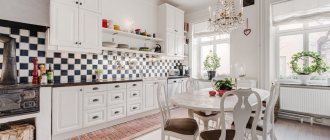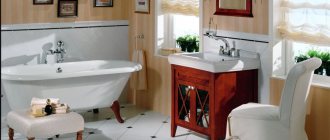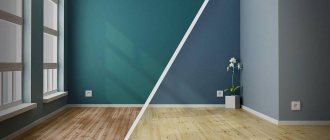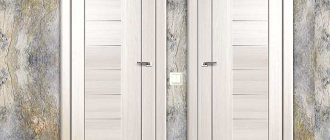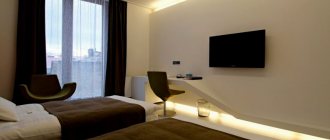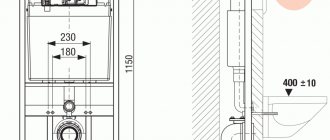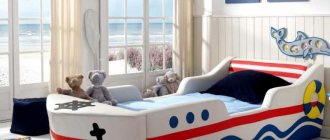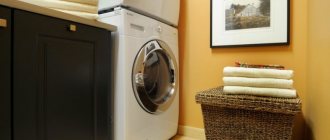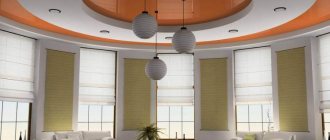The role of curtains in the bathroom
Many consumers are accustomed to doing without a screen in their bathroom, but those who regularly use this item know that in fact the curtain performs several functions at once:
- function . Any type of decorative curtain helps to clearly mark the area where water treatments are performed.
- The protective function is to prevent water and soap suds from getting on furniture, floors and, most importantly, on sockets. This is especially true when the sockets do not have protective covers and are located above the washbasin countertop in close proximity to the bathtub.
- In cramped conditions, when the bathroom is so small that you have to combine it with a toilet to achieve at least a slight feeling of spaciousness, an opaque curtain will create more private conditions for taking water procedures. With its help, all family members will feel comfortable visiting the bath at the same time.
- And of course decorative function. With the help of this element, which occupies a fairly large space, you can very quickly transform the interior of the bathroom and give it the desired mood. And if necessary, you can just as quickly radically change the situation by simply replacing the curtain with a new one.
Due to the fact that various materials are used to make curtains, you have the opportunity to choose the model that best suits the interior of your room. In addition, the design of this element can also be different.
Let's take a closer look at these features.
Materials used for manufacturing
The entire variety of curtains for bathrooms offered on trading platforms, depending on the materials used, can be divided into two large categories. In turn, they include several varieties.
Soft designs
Soft models include all types of curtains, which are made from the following materials:
- Curtains from fabrics. In no case should one assume that absolutely any piece of fabric that matches the pattern and shade of your room can be used as a protective screen. Only a special polyester fabric impregnated with a special water-repellent composition can properly isolate a wet area. This is explained by the fact that natural fabrics simply cannot withstand regular exposure to moisture, and the process of formation and reproduction of various fungi and bacteria will soon begin on their surface. The exception is expensive designer models made of linen or other natural fabric impregnated with special solutions. Fabric curtains are very pleasant to the touch. Many models have a weight on the bottom edge. This allows the curtain to keep its shape and maintain its desired position. The upper edge is also reinforced so that the fastening elements hold tightly, the curtain does not slip out under its own weight, and there are no marks left from the sharp teeth of the iron “crocodiles”. This type of curtain can be washed in a washing machine at a temperature of no more than 30 degrees and even ironed at low temperatures. Term their services with proper care can reach the figure 12 years old. This was reflected in their not the most democratic cost.
- Curtains from polyethylene. This is the most affordable, but at the same time the most impractical type of curtains Traces of exposure to detergents quickly appear on it, and if handled carelessly, they are easy to tear. But, despite their short service life, they are still popular due to the wide variety of colors and low cost. They can be either transparent or vice versa. Be plain or have absolutely any pattern. Probably, this variability of design captivates many consumers. One statement can still benefit them - they cope with their main function, waterproofing, excellently.
- Curtains from vinyl. This material is based on high strength polyvinyl chloride. Three types of this material are used - PVC (PVC), EVA (ethylene vinyl acetate) or PEVA (polyethylene vinyl acetate). Let's see if there is differences between them, because they can affect your health. PVC contains chlorine, which is known for its poisonous influence on the body. In addition to this harmful substance in the composition, PVC also contributes to the formation of a known carcinogen - dioxin. More than 108 harmful volatile organic substances can be emitted by a curtain made of low-quality PVC. Among them: toluene, ethylbenzene, phenol, xylene, acetophenol and many others. Be sure to check exactly what the curtain is made of before purchasing. Materials EVA and PEVA contain 10 times less harmful substances and do not have an unpleasant odor. The pattern is applied to their surface with special, health-safe, durable dyes. Over time, they do not lose their brightness and saturation. In addition to the distinctive composition, there are differences in density material. EVA is considered the densest, but differences in density do not affect the strength of the product. In terms of its characteristics, vinyl is superior even to fabric models, which have a fairly long service life. This material is very pleasant to the touch. It retains its shape well, does not absorb moisture at all, does not stretch, dries quickly, but is very pliable. This type of curtain can be washed by hand at a temperature of no more than 40 degrees, but under no circumstances should it be wrung out or ironed. They will return to their original shape under their own weight. Persistent stains are not an indicator that it is time to change the curtain, because they can be easily washed with chlorine-based detergents. The surface of this material does not absorb dirt and is not a suitable environment for mold to form. It should be noted that the varied design vinyl curtains. Their surface may have a relief, but remain transparent. It can also replicate the color of natural stone or very realistically imitate expensive silk fabric. Very popular are models that depict reproductions of paintings by famous artists. You can find striped curtains, with various geometric patterns or floral prints. In general, everything your heart desires. This type of curtain will not only be very practical and durable, but will also complement absolutely any interior solution. Despite all the advantages, the cost of vinyl screens remains affordable.
Having analyzed the three main types of soft curtains for the bathroom, we can conclude that polyethylene curtains are suitable only for those who quickly get bored with the monotony and regularly have a desire to change something in the interior. More practical and regular people, of course, will give preference to the first and last version of the products. The safest product in the last group will be a screen made of PEVA.
Rigid structures
They have characteristic differences from soft structures, which include not only the material used for their manufacture, but also the installation method. At the moment, only two types of material are used:
- Plastic – a lightweight synthetic material that is able to hold a given shape. The first plastic curtains appeared simultaneously with the release of the first shower stalls. It is very easy to apply any design to a plastic surface; due to its flexibility, curtains can have not only a strict rectilinear shape, but also various bends and curved sections. Thanks to this property of plastic, you can find stunning designer models of the most incredible shapes. The interior of a bathroom with such a curtain will be unique, and its cost will not be too exorbitant. TO shortcomings Plastic products can be attributed to their fragility. If there is an accidental impact, a crack will easily form on its surface or a small fragment will break off. Over time, streaks or cloudiness appear on the surface caused by constant contact with hard water and detergents. To avoid unwanted contamination, it is necessary to wipe the curtain dry every time after taking a bath. The first couple of times you will do this with some enthusiasm, but over time it will become quite tiring and annoying.
- Glass – a more noble material, and also environmentally friendly. Glass products can be classified as classic. This material is used everywhere. The durability and hygiene of glass products attracts many consumers. Needless to say, glass curtains are almost invisible, airy and weightless. They do not clutter up the space, do not make it heavier, but do an excellent job with the assigned tasks. The feeling of using such a product is slightly spoiled by the need for careful and regular care. After all, any, even the smallest soap stain will be very noticeable on a transparent surface. To simplify this point, modern manufacturers coat their products with a thin layer special anti-plague coverings. The difference is significant - drops of water will no longer leave traces in the form of limescale, and various contaminants will simply be repelled from the surface. It's not just in terms of maintenance that glass has surpassed plastic. It does not become cloudy even after many years, as it is not subject to aging. You will not see on the surface signs of material fatigue in the form of a network of thin cracks that can cover plastic. If you somehow manage to break a tempered glass curtain, then the possibility of injury will be zero. The material does not form sharp fragments, but breaks up into small round fragments. TO shortcomings glass products can be attributed to significant weight, high cost and inability to bend. If you need to make a curtain of a non-standard configuration, this will only be possible with an individual order, and the cost will be high. Tempered glass products are subject to destruction, but only with a very strong blow to the end.
Hard
Rigid curtains are made of tempered glass, plastic or polycarbonate. The frame is usually made of aluminum. Rigid curtains are used in bathtubs and showers. They are more durable and stronger than soft options.
Glass curtains
Frosted, clear, patterned or tinted glass is suitable for the bathroom. The choice depends on your preferences. A simple and universal option in shape would be a rectangular curtain. Oval-shaped curtain models are popular. They have a reinforced profile at the top and bottom: distortions are avoided.
By design, glass curtains are:
Swivel (open 90° C inward or outward)
Sliding (move to the side along special guide profiles. Sliding mechanisms are equipped with wheels that easily move along guide rails)
Folding (folds like an accordion. Pictured is the legko project)
Swing doors (open like a regular door)
Gilded fasteners, carved handles, and patterns on glass are used as decoration.
To decide whether or not to have a glass curtain in the bathroom, let's look at the pros and cons of the material.
Note: to prevent the appearance of mold, it is worth periodically changing the sealant between the frame and the glass.
What factors influence the choice of material
The choice of material for curtains should be based not only on the cost of the finished product, but also on its compatibility with the overall interior. We are talking about the stylistic features of your bathroom.
- If the room is decorated in Provence or another romantic style, with light-colored walls and ceilings, then a curtain made of ordinary polyethylene will instantly spoil the feeling of lightness and comfort inherent in this style. A textile curtain with a floral print in pastel colors is more suitable here. The shade of the picture may overlap with individual elements of the interior. Many styles have or end in frills and ruffles along the top edge. This option will be the most suitable.
- For discreet modern interiors in a minimalist style or loft A glass curtain would be an ideal addition. She will not draw attention to herself and will not spoil the decor with inappropriate ornaments.
- For the eco style, which is becoming more and more popular every day, both textile and glass screens are suitable. Glass will emphasize the naturalness of the interior. And textiles will make it softer and more comfortable. In this case, the background of the product may have the color of natural fibers and have a floral pattern in soft, green shades.
- Plastic curtains are suitable for bathrooms decorated in Scandinavian style. After all, these interiors are characterized by their simplicity and versatility.
- Classic rooms should be supplemented with fabric curtains that imitate heavy, luxurious fabric. For added effect, you can tie up the curtain with a decorative garter when it is not in use. A little gold or bronze shades will add chic, but will not look vulgar.
- Interiors in the Art Nouveau are easily recognizable due to the presence of a large number of curved lines and furniture of non-standard shapes. Plastic curtains can take the necessary shape with enviable ease. That is why they are favorites of many designers. Only their surface should not remain transparent or simply matte. Wood is the predominant material in this style. Therefore, if the furniture in the bathroom is made with imitation wood, let the surface of the curtain have a similar color.
- Curtain from polyethylene Suitable for bathrooms that do not have a distinctive style and whose color scheme is neutral. Not everyone decides to make the walls of the room bright red or orange, fearing that such decoration will quickly become boring. In such cases, you can diversify and add color using affordable and varied curtains made of this material.
As for such characteristics as the length of the product. The curtain can only reach the sides of the bathtub, which is not very practical, because its edges must extend at least 10 cm beyond them for reliable protection. The curtain can reach the middle of the bath or almost to the floor. The width of the curtain should be 15-20 cm longer than the bath itself.
Successful design examples
A fabric bathroom curtain can solve any problem and make your dream come true:
- If there are small children in the house, you can hang a curtain with a child's drawing. Select a product with images of dolls, cars or animals. When the children grow up, the curtain can be removed and thus easily get rid of the children's design.
Example of children's design
- A young girl’s bath should be decorated with a curtain with lush flounces.
- It is easy to find a suitable romantic design for newlyweds, which will turn the bathroom into a real paradise.
You might be interested in what is special about Vologda lace: the origin of the lace, simple patterns
Types of curtains for the bathroom
We have become familiar with the possible materials and interior features that influence their choice. Now let's look at the different types of hard and soft structures:
- The most familiar and common form of curtain is rectilinear. They can be either soft or hard and have the shape of a regular rectangle.
- A very rare species that is not yet often used - roll curtains They work on the principle of roller curtains for windows. Due to the small distribution, choosing the desired design will be very problematic. And their functionality is comparable to conventional screens made of thin fabric or polyethylene. The following types of screens can only be rigid.
- The swing type of curtains works on a principle similar to the operation of conventional interior doors. Either one or two sections can swing open at the same time. Such curtains will be appropriate only in spacious rooms, because when opened they will take up a lot of space. If the edges of the sashes are not glued with a special silicone tape, then water will fall through the gap onto the floor. Please pay attention to this point when purchasing. Typically, this type of curtain consists of two straight panels.
- Folding curtains operate on the “accordion” principle and can consist of either two or five sections. This structure allows you to repeat the contour of a curved bathtub having radius edges or many corners, but at the same time maintaining the simple shape of the canvases. The advantage of this type of curtains is their compactness and mobility. If you do not intend to use it, you can assemble it and turn it towards the wall. Thus, it will take up minimal space, which is very useful in small bathrooms. Typically, one edge of such a screen is mounted directly to the wall to give rigidity to the structure. This means that there should be no shelves, plumbing fixtures or other elements that would interfere with installation.
- The retractable curtain has only two panels. One of them is stationary and is attached directly to the side of the bathtub and to the wall, as in the previous version. And the second one extends if necessary. In this case, it can be attached to the first one using hinges, or have a guide with rollers at the bottom. This allows you to move it like sliding interior doors. This type is also a very compact solution.
- Corner views curtains will be the ideal solution for corner baths. They will most clearly reproduce the contours and will be more effective than an accordion. Corner structures can be hinged if the bathtub model has the shape of a quarter circle. If the bathtub is asymmetrical in shape, then when installed in a corner at the junction of two walls, one edge remains free. The blind part of the curtain, which is motionless, is attached to its side and to the wall. And the larger radius edge is protected by one or two curved doors.
- Partial This type of curtain can be used for any shape of bathtub. This screen is installed opposite the location of the faucet or shower stand, while the rest of the bath remains open. Usually this is one rectangular or radius sash that is attached to the side of the bathtub and to the adjacent wall.
The most affordable in terms of cost and ease of installation, of course, will be the rectilinear type of curtains. However, it cannot always effectively delimit the wet zone. When choosing the most suitable type of curtain, take into account the dimensions of the room and the characteristics of the walls. Glass curtains are heavy, which means the fastenings for them will be more serious. The gypsum partition will not be able to withstand such a load. The same goes for the bath itself. It must be securely installed and not wobble. If you can install acrylic products to the sides yourself, then when installing a curtain on a bathtub made of artificial or natural stone, it is better to seek help from specialists.
Methods for attaching soft curtains
Rigid structures are attached to the sides and walls. As for soft curtains, special curtain rods are designed for them. Budget models are made of durable plastic and can be sliding. This design allows you to maximally adjust the length of the cornice to the distance between the walls. It is enough to decide on the height, lean one edge close to the wall, and extend the other until it touches the opposite wall. By twisting the movable edge a little, you will fix it in the required position. The edges of such a cornice are sometimes made in the form of a cone or cylinder at the end of which there is a rubberized insert. With its help, the cornice “sticks” well to the surface of the tile and does not slip.
Sometimes such telescopic models are made of thin metal. Its surface is protected from corrosion by powder painting. The most reliable cornices are made from stainless steel or other metals, followed by a chrome coating. All of the above models are in the form of hollow tubes. Metal cornices can not only be smooth, but also have the shape of a circle, a fragment of a circle or a rectangle. This design allows you to hang a soft curtain not only in front of the bathtub, but also to protect it from all free sides.
Metal curtain rods are attached to the wall or ceiling using threaded connections, which are often included.
The curtain itself be attached to the cornice as follows:
- Using clothespins called "crocodiles". They can be metal, matching the cornice, or plastic. The undoubted advantage of using such fasteners is that there is no need to make holes in the curtain fabric. They especially securely fix thick vinyl or textile curtains that have a thickening at the top. Disadvantage "crocodiles" is that they can leave punctures on a thin polyethylene curtain. With sudden movement, the edge of the curtain can be pulled out, and in a humid environment, the metal clips can corrode and leave traces of rust on the canvas.
- Fastenings in the form of rings or hooks, strung on a cornice, imply the presence of special holes in the upper edge of the screen. To ensure that the holes in the curtain do not stretch and diverge over time, their edges are further strengthened by making the material thicker in this place, or by clamping the edges of the holes with metal plates.
- eyelets, which are used to attach ordinary curtains, are perhaps the most aesthetic and elegant option. Such fastenings are often found on fabric curtains and quite rarely on vinyl ones. Holes are made in the canvas that are larger than the diameter of the cornice to ensure smooth and free sliding of the curtain. Their edges are crimped with metal plates. Eyelets help create beautiful, smooth curves on the canvas. Their cost, compared to other types of fasteners, is quite high.
- One of the most modern fasteners - magnetic clamps. They are a loop with magnets attached to both ends. In order to fix the curtain on the curtain rod, it is enough to evenly place magnets on it, and then thread the rod through the resulting loops. To make them look more harmonious, their surface is decorated with decorative elements. The canvas holds quite tightly, because the magnets fit tightly to each other. However, they may still not be able to withstand a curtain that is too heavy.
- Sometimes, in order to “put” the curtain on the cornice, they make a special pocket. To do this, the top edge is folded several times and hemmed. After this, a long “corridor” for the rod is formed along the entire length of the curtain. In this case, you should first place the curtain on the curtain rod, and only then attach it to the wall. To be able to easily remove the curtain with a pocket, it is better to fasten the curtain rod using special arched stands, into which the rod simply rests without a rigid connection. A curtain hung in this way will hold very securely. However, significant disadvantage is the difficult sliding of the blade along the bar. Even if the pocket is several times wider than the diameter of the cornice, this does not make the task easier.
How to extend the life of a bathroom curtain
In order for your curtain to maintain a neat, tidy appearance for a long time, it requires proper care:
- If you are using a soft type of curtain, make sure that the fabric is completely dry after each water treatment. To do this, you need to let it hang for some time in a straightened form. The water will drain from the surface itself, after which you can assemble the curtain and move it to the side. If you neglect this rule, mold may form on its surface. Plastic curtains are especially susceptible to this.
- It is necessary to wash the curtains at regular intervals using delicate detergents. Even if your type of curtain can be machine washed, it is better to prefer hand washing. This way you will preserve the integrity of the surface longer and protect it from dents. To wash, soak the curtain in a bathtub with a small amount of detergent added. After it has “soured” a little, wipe the surface with a soft sponge and rinse with clean water. Do not wrinkle or twist the fabric too much. Severe bends may not straighten out.
- Plastic curtains should be wiped dry with a soft cloth after each contact with water. This way you will protect their surface from the accumulation of limescale and clouding.
- Never use abrasive cleaners to clean plastic products. Their surface is easy to scratch. When choosing a detergent, be sure to make sure that it is suitable for use on plastic surfaces and will not cause structural changes.
- Glass Although the curtains do not collect dirt on the surface and do not retain traces of drops, they will not resist rubbing with a soft cloth. They can be disinfected once every two weeks.
No extraordinary care is required. However, regular adherence to these rules will significantly extend the life of any type of curtain. If you haven't used this bath accessory before, be sure to try it. If not as protection from water, then as an interesting element of the interior.
Tags:Bathroom
Fabric ruffle curtain
The easiest way to make a stylish curtain for the bathroom is to sew beautiful decorative ruffles onto a ready-made product from the store. To do this, you need a piece of waterproof fabric, scissors for work, a sewing machine, as well as a ruler and pencil.
First, markings are made on the surface of the fabric with a pencil, along which the frills will then be sewn. Their number and width are a matter of imagination. Next, strips are cut out of the fabric to size - their length should be 5 cm longer than the length of the curtain. Next, the stripes are attached to the curtain according to the applied marks, after which the frills are sewn on the front side using a sewing machine.
Related article: Selecting decor for the bathroom
On video: how to sew a bath curtain.
